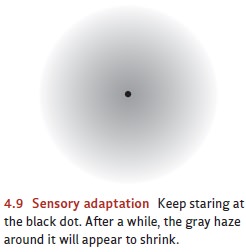Chapter: Psychology: Sensation
A Survey of the Senses: Sensory Adaptation
Sensory
Adaptation
One further consideration is also
relevant to all the sensory systems. Of course, our sensory responses are
influenced by the physical magnitude of the stimulus—and so the taste buds
respond more powerfully to a concentrated sugar solution than a weak one; the
eye responds more strongly to a bright light than a dim one. But our sensory
responses are also influenced by changes.
Thus, a sugar solution will taste much sweeter if you’ve just been tasting
something salty; a blast of room-temperature air will feel quite warm on your
skin if you’ve just come in from the cold.
The importance of change in
shaping our sensations shows up in many settings— including the phenomenon of sensory adaptation. This term refers to
the way our sen-sory apparatus registers a strong response to a stimulus when
it first arrives, but then gradually decreases that response if the stimulus is
unchanging. Thus, when we first walk into a restaurant, the smell of garlic is
quite noticeable; but after a few minutes, we barely notice it. Likewise, the
water may feel quite hot when you first settle into the bathtub; a few moments
later, the sensation of heat fades away.
Sensory adaptation is easily
documented both in the lab and informally. Here’s an example: Stare at the dot
in the center of Figure 4.9, trying not to move your eyes at all. After 15 or
20 seconds, the gray haze surrounding the dot will probably appear to shrink
and may disappear altogether. (The moment you move your eyes, the haze is
restored.)

What’s happening in this case?
The gray haze is initially a novel stimulus, so it elic-its a strong response
from the visual system. After a moment or two, the novelty is gone; and, with
no change in the input, the response is correspondingly diminished. It’s
important for this demonstration, though, that the haze has an indistinct edge.
While looking at the figure, your eyes will tremble just a bit, so the image of
the haze will shift slightly from one position on your eye to another. But,
because the edge of the haze is blurred, these shifts will produce very little
change in the stimulation—so the haze slowly vanishes from view. (With more
sharply defined contours, small changes in eye position will cause large
changes in the visual input. As a result, even the slightest jit-ter in the eye
muscles will provide new information for the visual system. This helps us
understand why you can stare out the window for many minutes, or stare at a
computer screen, without the input seeming to vanish!)
What do organisms gain by this
sort of sensory adaptation? Stimuli that have been around for a while have
already been inspected; any information they offer has already been detected
and analyzed. It’s sensible, therefore, to give these already checked inputs
less sensory weight. The important thing is change—especially sudden
change—because it may well signify food to a predator and death to its
potential prey.
Related Topics